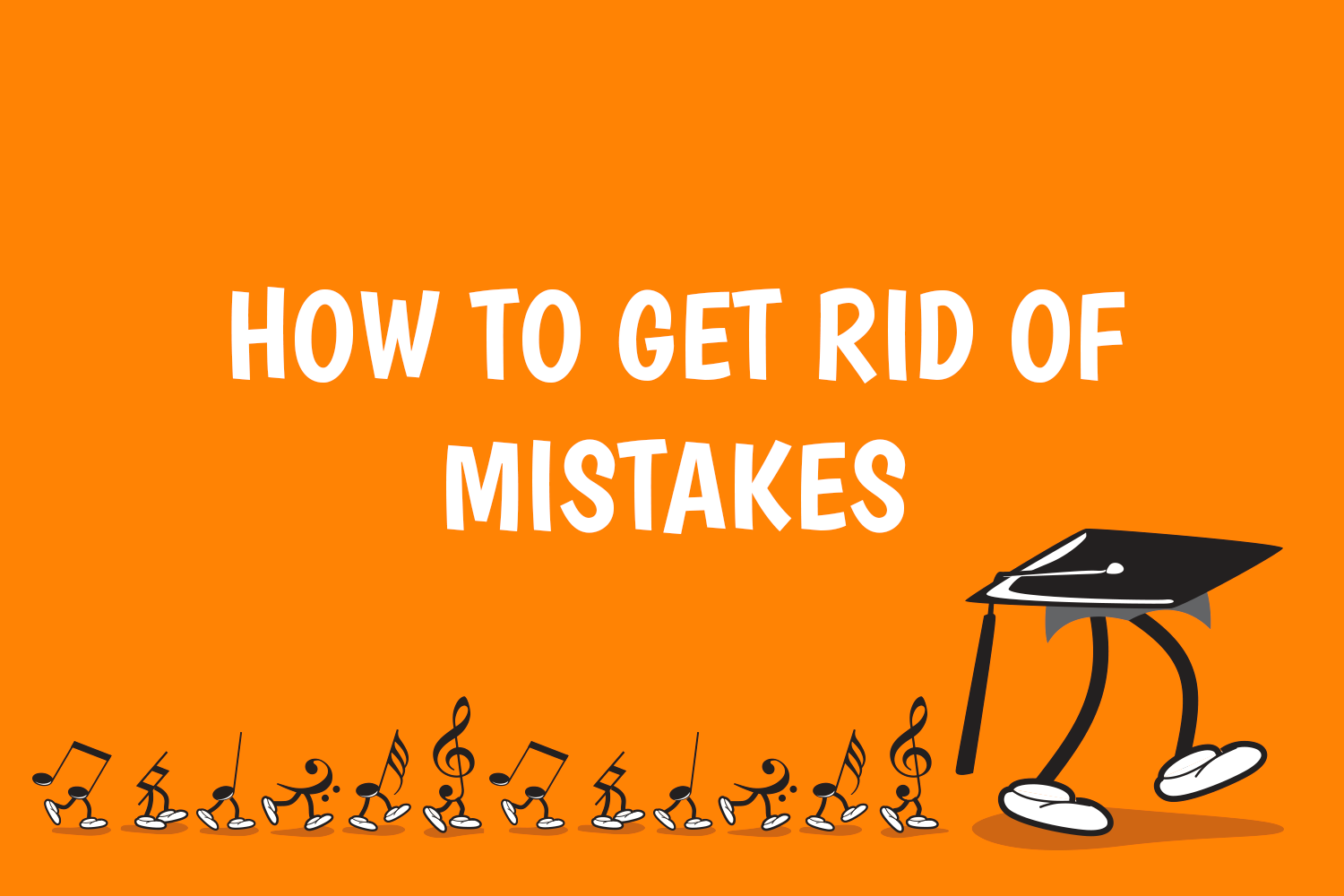How to Get Rid of Mistakes

My daughter recently came home from her flute lesson with a great little system for correcting mistakes, which she called ‘IRC’.
IRC stands for Isolate, Rhythms, Connect.
Her flute teacher, Emma Sholl (of SSO fame), discussed with her that ‘Isolate’ means to figure out exactly where the mistake is. ‘Rhythms’ means to go over and over that spot in different ways, primarily using different rhythms. ‘Connect’ means to then link that passage back to the rest of the piece. Cool!
I was really pleased to hear about this system, because I do something quite similar with my piano students, although we’ve never come up with a great little acronym for it. But for pianists, it’s usually not quite as simple as the three steps above.
The first problem is that the student sometimes cannot easily isolate the mistake, mainly because they don’t know what the mistake actually is.
They can hear something is wrong, so they go back to the beginning of the section (or worse, the beginning of the whole piece, even if the mistake happened towards the end) and try again, hoping the mistake won’t happen again. If something does go wrong again, they go back again. And again. And again. Sadly and ironically, by going back and repeating the same mistake over and over, the actual mistake has been “practised in” or at least given as much air-play if not more than the correct version.
If the mistake does happen to disappear, which it sometimes does, the students then keeps going, relieved to have ‘gotten through’ that bit!
But how did the mistake disappear? The student has not fixed the mistake. By going back again and again, the student is trying to get the fingers to ‘just do it’, rather than really knowing what to do. To play the passage correctly now involves a bit of fluking, a bit of luck. And since the relieved student, upon hearing it correctly, charges ahead rather than going over the passage (for fear of the mistake reappearing), there is no knowing whether the passage will be correct next time or not. (Well actually we DO know – most likely not.)
Then there is another type of mistake, one that is often not even recognised as a mistake: the gap. The pause. The interruption to the rhythm that occurs when hands are not ready. The slight hesitation when the wrong finger is about to go on the note and then hurriedly changed (I often call this one a ‘micro-mistake’). This type of mistake to fix, because students can’t hear it. They are concentrate on getting the notes right, not on getting the piece fluent.
So, how does one isolate a mistake, no matter what kind? It’s pretty scary: it involves stopping, listening, reconciling with the notes on the page, checking the fingering, practising jumping the distance between notes and chords. Sometimes the mistake is really in the left hand when you think it’s in the right hand. Sometimes the actions of one hand are CAUSING the mistake in the other hand. (No wonder students don’t want to do this; it’s not nearly as much fun as ‘playing through’ the piece from beginning to end, which is the common approach at home.)
Correcting mistakes can be more challenging for pianists than for other instrumentalists. For example, most of the above paragraph is not applicable to flute playing, because on the flute both hands are working together to produce the same note, and most notes on the flute can only be produced with one type of fingering. But pianists have ten fingers which can make ten different sounds, sometimes simultaneously, and these same sounds can be created with a huge variety of different fingerings! For this reason, mistakes can be a lot harder to find, let alone fix.
For a pianist to isolate a mistake, he/she must first stop (not just fix it and then keep going), rewind a little bit (not all the way to the beginning of the piece), and figure out where the mistake is coming from (i.e. which hand, which note, which finger). This can be tricky. But now comes something even tricker: to recreate the mistake. (This will be the new ‘R’!)
We don’t want to spend a lot of time recreating and we certainly don’t want to reinforce the mistake any more than it already has been, but to be able to actually recreate the mistake means a student knows exactly what the mistake is, and is aware enough to avoid it next time around.
A mistake in the sound is often quite straightforward to recreate. But if the mistake is a fingering mistake, a problem unique to pianists, students may be completely unaware. It takes very careful playing to figure out which finger you are supposed to use vs which finger you DID just use! Fingering is a bit like choreography – keep changing it all the time and eventually the whole routine will just crash.So it really is worth figuring out which fingering you’re accidentally using, even if that means realising you’re using a different fingering each time. This is still valuable information.
Getting back to the acronym, so far we have ‘I’ for isolate and ‘R’ for recreate.
The ‘R’ according to the flute teacher was for ‘rhythms’. Playing a passage in different rhythms certainly does help it to become more smooth and confident. But this assumes that the notes themselves are already correct. There are lots of different strategies students can employ to get rid of mistakes, so the rhythms strategy will be incorporated into… ‘E’ for eradicate.
Eradicating a mistake, or as one of my [teenage boy] students put it, to ‘surround and kill’ a mistake, means to completely and totally erase it from existence. The most common way that most young pianists try to do this is by playing the passage separate hands over and over. The mistake appears to be gone. But then they play it with both hands, and the mistake comes back. This is because the mistake only occurs when both hands are playing at the same time. So to eradicate it, the student must use both hands at the same time.
Here are a few suggestions of ways in which pianists can eradicate mistakes:
1. Rewind one or two beats before the mistake you’re trying to correct. Start playing and ‘freeze’ on the note or chord that was going wrong, taking special care to play the right notes with the right fingering. Do this quite a few times. At first there will be big pauses while finding the correct notes to ‘freeze’ on, but after a while the brain starts to anticipate the notes in question and everything becomes more fluent.
2. Play in different rhythms AND different accents. This mainly applies to scale passages.
3. Practice ‘backwards’ – that is, practice one bar, then the bar before it, and so on.
4. Practice the passage at different speeds – not just slower, but sometimes a lot faster
5. Go backwards and forwards between two tricky chords, sometimes playing each chord two or three times each.
So now we have ‘IRE’ – Isolate, Recreate and Eradicate. This is good. But eventually we really do want to play through from the beginning. How do we put the piece back together?
This is where ‘C’ for connect comes in. It would be fair to assume that a mistake that has been isolated, recreated and eradicated successfully within the context of the small passage being practised should then be gone when the piece is played form the beginning. But so often the mistake reappears when it is put back into the context of the piece. This can be so frustrating! What needs to happen at this point is a widening of the practice ‘area’ – that is to include a few more bars before and after the mistake, and continue to apply the ‘IRE’ concept. The fingers need to play the newly corrected notes under all sorts of conditions, and it may take a few days before the mistake really is gone. Now we are connecting it – and for the sake of assonance, we’ll change ‘connect’ to consolidate.
Isolate, Recreate, Eradicate, Consolidate. This systems works to get rid of mistakes. Hope you find it useful!
